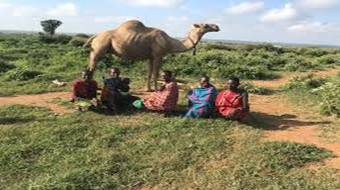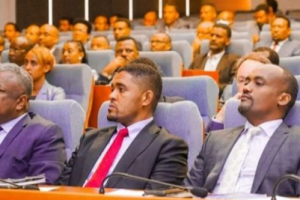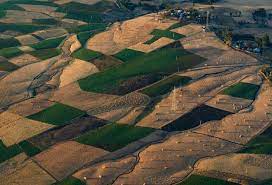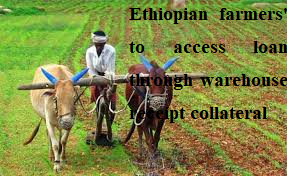
Agriculture is the main stay of the nation’s economy and almost 80 % of the population earns its living from the sector. It also contributes up to 90 % of export earnings.
However, the subsistence and traditional way of farming made vulnerable to climate variation which poses drought and flood to the other extreme.
The livestock sub sector also faces similar challenges. Pastoralists move from place to place in search of forage and water and lose many of their cattle during extreme weather condition.
In time of hardship, farmers subsist on stored grains but it tides them over only for shorter period. As the result, they will be forced to seek handouts from donors. This has been a common practice since 1950s.
Now time is changing and farmers began to develop a culture of modern saving system by their credit associations so that could overcome the penury they face during drought season.
Such approach draws the attention of donors and private financial institutions and show interest to provide insurance coverage in the form of weather index and so far the practice is undergoing in several parts of the country and until now, thousands of farmers have been benefiting.
Solomon Zegeye is working in the Nyala Insurance Company as a Manager of Micro Finance Department. As to him, his company has long been delivering its financial inclusion duties through the provision of various models of micro insurance with the cooperation of the government, international nongovernmental organizations and the World Bank.
It is also the pioneer of Agricultural micro Insurance in Ethiopian market. The company strategically operates on three insurance business areas and among others General insurance business, Long-term Insurance and Micro insurance business including crop, livestock and Life and health.
Poverty is more rampant in the rural part than the urban areas. In Ethiopia 60 percent of the population is living in the high lands of the country with various agro ecological zones engaged in sedentary farming. The rest of the population which accounts for 40 percent inhabits the lowlands engaged in pastoral and agro pastoral activities.
About 13 million smallholder farmers account for 90% of agricultural GDP. Nearly 55% of the smallholder food producers are engaged in a plot of land which is one hectare wide or less.
In the densely populated areas of the central and southern parts of the country due to land scarcity farmers yield is declining from time to time and in time of drought, their living is hard hit. Hence, reaching them through financial inclusion scheme helps to withstand the crises.
The company has a strategy to create partnership with stakeholders engaged in rural financial service, smallholder agricultural development, agricultural value chains, financial services and digital technology to low-income urban population.
According to Solomon, micro insurance service takes various models. Livestock insurance products are dictated or determined by agro-climatic conditions and livelihood systems.
The other model known as indemnity based livestock insurance that covers risks like disease/illness, accident, calving, windstorm, smoke, electrocution, flood and snakebite. It is also provided for commercial growers and small-holder farmers in highland and agro-pastoral livelihood areas.
Drought insurance is extremely vital because drought significantly risks the livelihood of the pastoralists. The index based livestock insurance solely practiced in low-land, arid and desert agro-ecologies and conducted through gathering Satellite Index.
For the scheme financial and Technical support provided by World Food Program and Product design and pricing done by consultant from United Kingdom and International Livestock Research Institute also took part in it.
National Meteorological Agency served as calculation agent regarding interpreting the information collected from satellites.
There are four local insurance companies which carry risks on pool basis with Nyala Insurance taking the technical aid to provide reinsurance protection.
Farmers and pastoralists are required to purchase Premium through their saving and credit associations but usually up to 100% of it subsidized by the donor-World Food Program. The insurance coverage is provided for long and short rain periods.
If the data received from satellite indicates that there was rain failure, pastoralists or sedentary farmers would be paid costs of purchasing feed, water and drug intervention areas.
So far in the regions such as in Beneshalgul-Gumuz and Amhara totally 6500 small scale farmers received 50 million birr because of the crop failure due to drought in 2024. Farmers allocated the money to purchase grain for personal consumption, seeds and agricultural inputs for the next harvest season.
As to Solomon, the areas that have been hit by recurrent drought based on the data brought from satellite in Somali Region in the places known as Adadele, Kebri Dehar and West Elimi and some 5000 beneficiaries received more than 70 million birr.
In addition, in Afar region three woredas 3200 pastoralists have received more than 8.8 million birr. The money is allocated for purchasing drug to treat their infected animals. From time to time the number of beneficiaries also increased but there are also challenges which need remedial actions and among others, lack of technical skills in product design and index based pricing.
As to Solomon, some of the forwarded solutions to address the mentioned short comings are scaling up and sustaining micro insurances and to that end there must be collaboration among stake holders.
Encouraging innovative public private partnership and the major stakeholder, the government, which plays crucial role in poverty alleviation should create enabling environment by formulating legal framework and introducing proclamation helpful for micro insurance development and supporting innovation technologies for premium collection.
The agriculture sector which comprises both sedentary and livestock are the main stay of the economy and created job opportunity to more than 85 percent of the labor force. But as the mode of production is primordial and traditional its productivity is insignificant. As the result, its contribution to the economy is less than the expected.
Worse to these, in time of extreme weather conditions, in drought or in rainy season the sector is easily vulnerable. In time of drought when rain fail or delayed crop will fail and consequently the farmer’s livelihood will be devastated. During such circumstances farmers are left with only two choices; namely to leave their places or rely on relief aid.
The pastoral community also will be critically affected. Due to drought water and grazing resources will be dwindled and until they get sufficient aid many animals will be endangered and dead.
Two years ago, more than 1.5 million cattle lost their life when drought occurred in the South East of Ethiopia. The absence of sufficient infrastructure complicated delivery of relief aid. This in turn caused high death rate further jeopardizing the livelihood of the community. Supplying the animals to the market also could be impossible because of the absence of viable roads. The same is true during high flood time due to heavy rain. Famer’s crops and pastoralists animals will be taken away by flood. Restoring the drought shattered farmers and pastoral community livelihood will take years.
In the last three decades drought has been a recurrent phenomenon witnessed every two years. Drought and flood induced by climate change and global warming critically affected agricultural sector globally. What matters is how countries develop a coping mechanism to with stand the challenge.
The advanced countries with high technology, finance, well trained human resource and accumulated knowledge could with stand the devastating impact that occurs due to extreme weather conditions. They have well developed information system obtained from satellite which enable them to deter the negative consequence of the weather condition beforehand. However, developing countries including ours suffer from the brunt of climate disaster due to the weak capacity to with stand the catastrophe. Hence enhancing the weather insurance index to protect farmers and pastoralists livelihood should be strengthen. In line with this cultivating saving culture is essential.
BY ABEBE WOLDEGIORGIS
THE ETHIOPIAN HERALD FRIDAY 7 MARCH 2025





